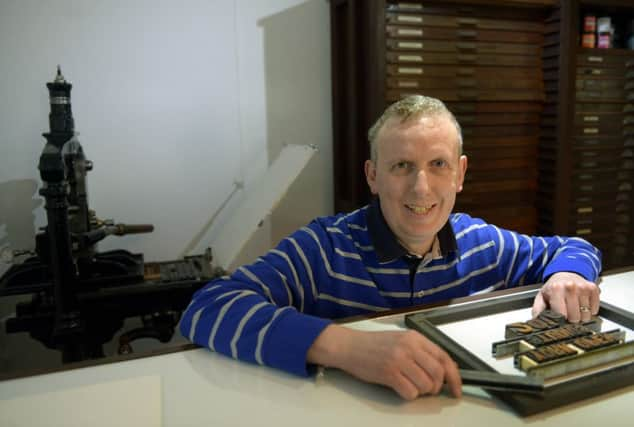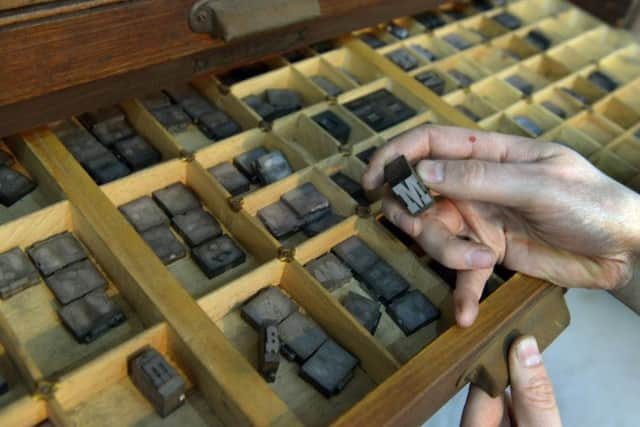Bonny prints'¨charming


“I moved from London to York over a decade ago and for a while ran a pottery painting studio. At the time a few of the artists who worked there were experimenting with letterpress printing and that’s what sparked my interest. I would never describe myself as an artist, but I have always been pretty practical and like the idea of restoring old machinery. The two things came together. Four years ago I bought my first printing press and set of fonts and I haven’t stopped ever since.”
Right on cue, a van pulls up. Inside is another wooden cabinet which looks almost identical to the half a dozen or so already in his studio. It belongs to a former printer and contains his collection of old letterpress fonts.
Advertisement
Hide AdAdvertisement
Hide Ad“He died not all that long ago and his daughter didn’t know what do with it,” says Steve. “When technology moved on, this old equipment almost became obsolete overnight and so much of it either ended up in skips or rusting in redundant buildings.


“I guess I am now on a bit of a mission to ensure that what is left isn’t consigned to history. There is something quite beautiful about these presses and having had a go at printing a few posters you can see what a real skill it was. Some of these fonts are so tiny that it’s a miracle they could even see what they were doing.”
Steve bought his first printing press in 2012. The Albion press, which now sits gleaming in the corner of his workshop, was in a pretty sorry state. Made in 1890 and originally used to create instruction manuals for the shipbuilding industry, by 1960 it had found a new home in a school’s art department.
“It was still in working condition when it arrived here, but there were several major cracks in it and it needed completely stripping down. I’ve polished it, painted it and completely reassembled it. It’s now pretty much as good as new.”
Advertisement
Hide AdAdvertisement
Hide AdThe press has been joined by four others and having decided that there was little point in keeping this little slice of history locked away, Steve is now keen to share it with others. Not only is he taking part in the York Open Studio events next weekend, he has secured a licence from Rowntrees to print some of their historic designs, including the York company’s iconic early KitKat advertising, and his York Letterpress Facebook site is an online celebration of the old art form.


“Computer packages have made design so much easier, but the results are almost too perfect. The appeal of the letterpress is that you can see evidence of a human hand. The letters are often not completely perfectly aligned and there is a texture to the final artwork which you don’t get with modern methods.”
Steve says there is a general revival in the art of letterpress. Birmingham’s two universities have set up a joint department dedicated to recording the history of British printing and Steve also applied to have a screening of the American documentary Pressing On in York.
“The Centre for Printing History was set up to encourage research into all aspects and periods of printing history and culture, as well as education and training into the art and practice of printing,” says Caroline Archer, from Birmingham City University. “Like so many industries, the value of what went before is often not realised until it is too late. Part of our job is to make sure the printing presses which have survived are really treasured. Increasingly, I think letterpress is being seen as antidote to the digital age. It’s a process that can’t be rushed. There is a real active community of letterpress artists and collectors in this country and our aim is to be a place where those passions can be channelled.
Advertisement
Hide AdAdvertisement
Hide Ad“Ultimately we would love to see a printing museum set up because there are so many stories about British society which you can tell through this industry.”
Having become a champion for letterpress, Steve is now keen to find out more about the Yorkshire firms that manufactured the typefaces, in particular HM Sellers. Based at Shalesmoor in Sheffield, it was a major manufacturer of letterpress, but aside from an old newspaper cutting from 1939 about a factory blaze, he is struggling to find out what happened to the firm.
“Piecing together what happened to many of these companies is a bit like solving a mystery, so any new information would be welcome. You know it’s funny, those artists at my old pottery studio eventually moved on to other mediums, but by the time they had I had become a letterpress convert and it’s too late to turn back now.”
n Steve Bowen’s workshop will open its doors to the public as part of York Open Studios, which runs from April 15 to 17 and 23 to 24. For the full programme go to yorkopenstudios.co.uk. Find out more about Steve’s work at www.facebook.com/yorkletterpress